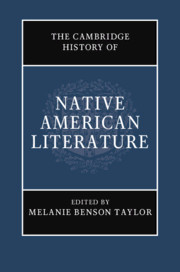Book contents
- The Cambridge History of Native American Literature
- The Cambridge History of Native American Literature
- Copyright page
- Contents
- Figures
- Contributors
- Introduction: What Was Native American Literature?
- Part I Traces and Removals (Pre-1870s)
- Part II Assimilation and Modernity (1879–1967)
- Part III Native American Renaissance (Post-1960s)
- Part IV Visions and Revisions: 21st-Century Prospects
- 23 Native American Horror, Fantasy, and Speculative Fiction
- 24 Charting Comparative Indigenous Traditions
- 25 The Global Correspondence of Native American Literatures
- 26 Indigenizing the Internet
- 27 Indigenous Futures beyond the Sovereignty Debate
- 28 The Leftovers
- 29 Can You See the Indian?
- Index
- References
23 - Native American Horror, Fantasy, and Speculative Fiction
from Part IV - Visions and Revisions: 21st-Century Prospects
Published online by Cambridge University Press: 18 September 2020
- The Cambridge History of Native American Literature
- The Cambridge History of Native American Literature
- Copyright page
- Contents
- Figures
- Contributors
- Introduction: What Was Native American Literature?
- Part I Traces and Removals (Pre-1870s)
- Part II Assimilation and Modernity (1879–1967)
- Part III Native American Renaissance (Post-1960s)
- Part IV Visions and Revisions: 21st-Century Prospects
- 23 Native American Horror, Fantasy, and Speculative Fiction
- 24 Charting Comparative Indigenous Traditions
- 25 The Global Correspondence of Native American Literatures
- 26 Indigenizing the Internet
- 27 Indigenous Futures beyond the Sovereignty Debate
- 28 The Leftovers
- 29 Can You See the Indian?
- Index
- References
Summary
From the uncanny werewolf families and zombie border patrol guards in the novels of Stephen Graham Jones (Blackfeet) to the digital citizens and virtually-enhanced tourists in Cherokee writer Blake Hausman's novel Riding the Trail of Tears, Native Americans are creating strange and scintillating new worlds of unforeseen horrors and possibilities. Such works engage the popular genres of horror and fantasy in order to mobilize sophisticated political critiques of capitalism, globalization, and the colonial imbrications of Indigenous peoples, albeit in surprising, genre-bending forms. This chapter explores the features of this new and vibrant field, offering readings of some of its most provocative titles and suggesting ways that such works can help critics and readers chart fresh, productive pathways into both the histories and the futures of North American Indigenous populations. In the very act of strengthening and deepening the connections between the speculative and the real, Native writers craft methodologies of resistance.
Keywords
- Type
- Chapter
- Information
- The Cambridge History of Native American Literature , pp. 431 - 446Publisher: Cambridge University PressPrint publication year: 2020



